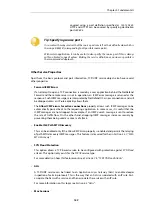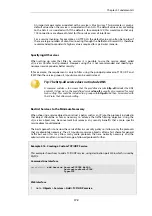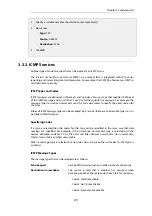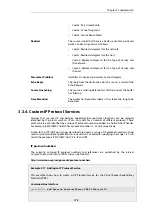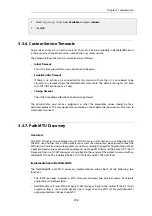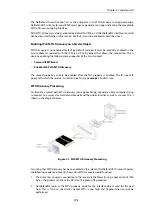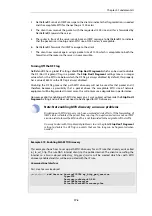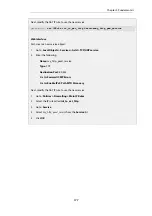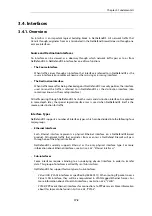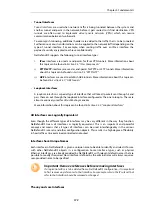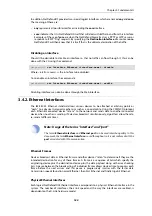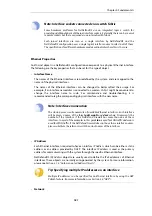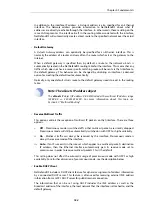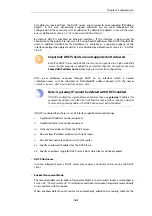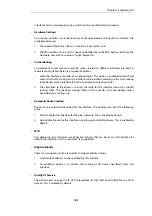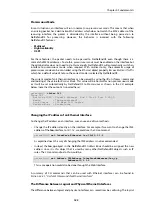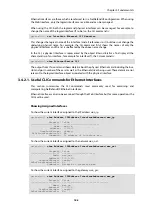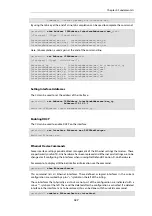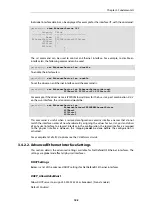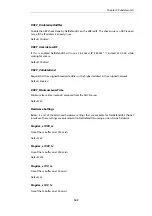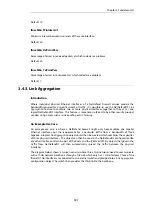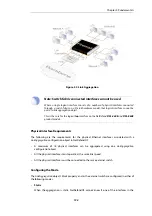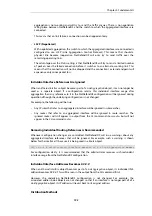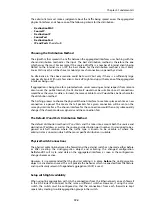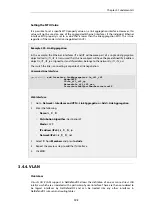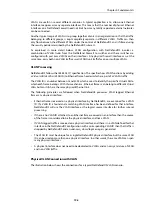
In addition to the interface IP address, a
Network
address is also specified for an Ethernet
interface. The Network address provides information to NetDefendOS about what IP
addresses are directly reachable through the interface. In other words, those residing on the
same LAN segment as the interface itself. In the routing table associated with the interface,
NetDefendOS will automatically create a direct route to the specified network over the actual
interface.
•
Default Gateway
A
Default Gateway
address can optionally be specified for an Ethernet interface. This is
normally the address of a router and very often the router which acts as the gateway to the
Internet.
When a default gateway is specified then, by default, a route to the network
all-nets
is
automatically created in the NetDefendOS routing table for the interface. This means that any
traffic which does not have a more specific matching route will be sent via that interface to
the default gateway. This behavior can be changed by disabling an interface's advanced
option for creating the default route automatically.
Normally, only one default
all-nets
route to the default gateway needs to exist in the routing
table.
Note: The all-nets IP address object
The
all-nets
IP object (IP address: 0.0.0.0/0) includes the multicast IP address range
(224.0.0.0 => 239.255.255.255). For more information about this topic, see
Section 4.7, “Multicast Routing”.
•
Receive Multicast Traffic
This option controls the reception of multicast IP packets on that interface. There are three
options:
i.
Off - Promiscuous mode is switched off so that multicast packets are silently dropped.
Promiscuous mode will still be automatically switched on with OSPF or high availability.
ii.
On - Multicast traffic can always be received by the interface. Promiscuous mode is
always the receive mode of the interface.
iii.
Auto - If an IP rule exists in the rule set which applies to a multicast packet's destination
IP address, then the Ethernet interface automatically gets its receive mode set to
promiscuous in order to receive multicast packets. This is the default.
This setting does not affect the automatic usage of promiscuous mode with OSPF or high
availability. For a further discussion of promiscuous mode, see the description below.
•
Enable DHCP Client
NetDefendOS includes a DHCP client feature for dynamic assignment of address information
by a connected DHCP server. This feature is often used for receiving external IPv4 address
information from an ISP's DHCP server for public Internet connection.
The information that can be set using DHCP includes the IPv4 address as well as the
broadcast address of the interface, the local network that the interface is attached to, and the
default gateway.
Chapter 3: Fundamentals
182
Summary of Contents for NetDefendOS
Page 30: ...Figure 1 3 Packet Flow Schematic Part III Chapter 1 NetDefendOS Overview 30 ...
Page 32: ...Chapter 1 NetDefendOS Overview 32 ...
Page 144: ...Chapter 2 Management and Maintenance 144 ...
Page 284: ...Chapter 3 Fundamentals 284 ...
Page 392: ...Chapter 4 Routing 392 ...
Page 419: ... Host 2001 DB8 1 MAC 00 90 12 13 14 15 5 Click OK Chapter 5 DHCP Services 419 ...
Page 420: ...Chapter 5 DHCP Services 420 ...
Page 573: ...Chapter 6 Security Mechanisms 573 ...
Page 607: ...Chapter 7 Address Translation 607 ...
Page 666: ...Chapter 8 User Authentication 666 ...
Page 775: ...Chapter 9 VPN 775 ...
Page 819: ...Chapter 10 Traffic Management 819 ...
Page 842: ...Chapter 11 High Availability 842 ...
Page 866: ...Default Enabled Chapter 13 Advanced Settings 866 ...
Page 879: ...Chapter 13 Advanced Settings 879 ...


